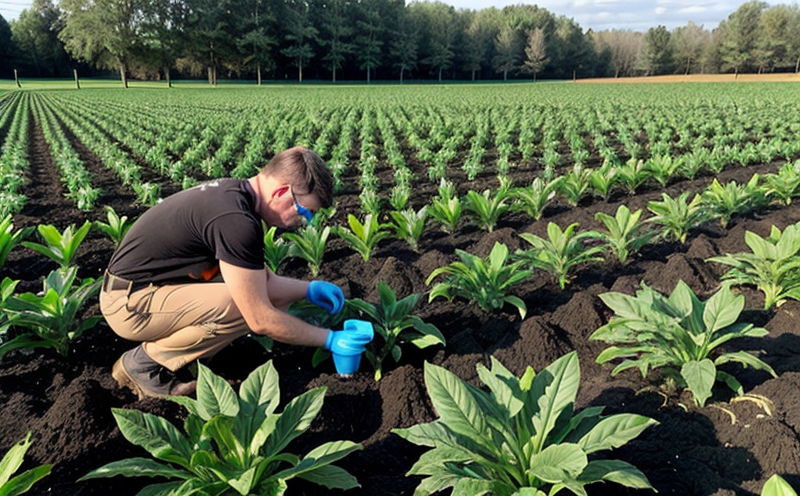Magnesium Content Testing in Fertilizers
In the realm of agriculture and forestry testing, ensuring that fertilizers meet specific nutrient content requirements is crucial. Magnesium content plays a pivotal role in plant health and crop productivity. This section delves into the nuances of magnesium content testing in fertilizers, providing insights into its importance for quality managers, compliance officers, R&D engineers, and procurement teams.
The testing process involves several critical steps, starting with the selection of appropriate samples. Samples must be representative of the batch to ensure accurate results. Once collected, these samples undergo rigorous preparation techniques that include drying, grinding, and sieving to achieve a consistent particle size suitable for analysis.
For magnesium content determination, atomic absorption spectrophotometry (AAS) is widely used due to its high sensitivity and precision. This method allows for the accurate measurement of trace elements like magnesium. Another popular technique is inductively coupled plasma-optical emission spectroscopy (ICP-OES), which offers excellent detection limits and versatility.
The acceptance criteria for magnesium content in fertilizers are stringent, adhering to international standards such as ISO 14215:2017 for soil quality. Compliance with these standards ensures product consistency and reliability across different batches. The target range for magnesium content varies depending on the type of fertilizer; however, it generally falls within a narrow band.
Understanding the role of magnesium in plant physiology is essential for interpreting test results correctly. Magnesium acts as a central component of chlorophyll, enabling photosynthesis and energy transfer processes within plants. Deficiencies can lead to stunted growth and reduced yield, while excesses may cause toxicity issues. Therefore, precise measurement and control over magnesium content are vital.
The testing process also involves potential challenges such as sample variability and interference from other elements present in the fertilizer matrix. Advanced techniques like multi-element calibration standards help mitigate these issues by providing accurate baseline data for comparison.
Quality assurance measures ensure that every batch of tested fertilizers meets specified nutrient content, including magnesium levels. Regular audits and cross-verification methods further enhance reliability and accuracy. These practices contribute significantly to maintaining high standards in the agricultural sector, ensuring optimal crop performance and sustainability.
Quality and Reliability Assurance
The importance of quality assurance cannot be overstated when it comes to magnesium content testing in fertilizers. Compliance with international standards not only guarantees product consistency but also builds consumer trust and confidence. Regular calibration checks on analytical equipment ensure that results remain accurate over time.
Compliance officers play a vital role in overseeing these processes, ensuring adherence to regulatory requirements set by bodies like the Environmental Protection Agency (EPA). They work closely with R&D engineers to refine testing protocols based on feedback from field applications. This collaborative approach helps identify areas for improvement and innovation within the industry.
Sampling methods are critical for obtaining representative samples that reflect true batch characteristics. Advanced sampling techniques, such as random sampling or stratified random sampling, provide more reliable data than simple grab samples. Proper sample preparation techniques further enhance the accuracy of subsequent analyses by minimizing variability introduced during handling.
R&D engineers focus on developing new testing methods and improving existing ones to meet evolving industry needs. Their efforts contribute significantly towards reducing measurement uncertainties associated with magnesium content determination. Continuous improvement initiatives ensure that analytical processes remain at forefront of technological advancements.
Environmental and Sustainability Contributions
Eco-friendly practices have become increasingly important in agriculture due to growing concerns about environmental sustainability. Magnesium content testing supports these efforts by helping farmers apply fertilizers efficiently, thereby minimizing waste and reducing the risk of runoff into water bodies.
Sustainable farming practices rely heavily on accurate nutrient application rates. By ensuring that magnesium levels are optimal for each crop type, farmers can reduce unnecessary inputs while maximizing yields. This leads to lower fertilizer costs and reduced environmental impact.
The use of precision agriculture technologies such as soil sensors and drones allows real-time monitoring of field conditions. This data-driven approach enables more precise application of magnesium-rich fertilizers where they are most needed, further enhancing resource efficiency.
Compliance with environmental regulations is crucial for maintaining a positive reputation among consumers who increasingly seek out eco-friendly products. Companies that demonstrate a commitment to sustainability through rigorous testing and quality assurance measures stand to benefit from enhanced brand loyalty and market share growth.
Competitive Advantage and Market Impact
In today’s competitive agricultural landscape, having accurate magnesium content testing capabilities provides significant strategic advantages. Companies that invest in cutting-edge technology and robust quality control systems gain a competitive edge by consistently delivering high-quality products.
The ability to quickly adapt to changing market demands is another key factor influencing success. By staying ahead of trends through ongoing research and development efforts, companies can introduce innovative solutions that meet evolving customer needs.
Meeting stringent regulatory requirements demonstrates a company’s commitment to responsible business practices. This builds trust among consumers and stakeholders alike, fostering long-term relationships based on mutual respect and shared values.
Eco-labeling schemes provide an additional opportunity for differentiation within the marketplace. Companies that earn certifications for their sustainable practices can command premium prices and tap into niche markets seeking environmentally conscious products.





